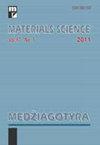冷却工艺对低碳贝氏体钢组织和性能的影响
IF 0.6
4区 材料科学
Q4 MATERIALS SCIENCE, MULTIDISCIPLINARY
引用次数: 0
摘要
本文采用Mn-Mo-Cr-B低碳贝氏体钢作为实验材料。利用Gleeble-1500D热模拟试验机确定了该钢在连续冷却过程中的连续冷却转变曲线,并建立了相应的贝氏体钢在连续冷却过程中的相变模型。研究了不同冷却速率和最终冷却温度对钢组织和力学性能的影响。采用金相、扫描电镜和EBSD等技术研究了低碳贝氏体钢的显微组织、晶体取向和晶界角分布,并研究了它们与钢的强度和韧性的关系。研究结果表明,不同的冷却速率和最终冷却温度会影响钢的相变过程和组织,从而间接影响钢的力学性能。随着冷却速度的增加,马氏体的扩散和细度增加,板条贝氏体的数量增加,板条变细。最终冷却温度的升高导致马氏体-奥氏体岛变大,板条贝氏体数量减少,导致板条变宽。通过对贝氏体钢亚组织的分析,确定了试样中的贝氏体组织依次为初生奥氏体晶粒、板条包、板条块。板条包由具有不同方向的板条块组成,其中板条大小主要控制强度。板条尺寸越细,强度越高,亚结构对韧性的影响相对较小。本文章由计算机程序翻译,如有差异,请以英文原文为准。
Effect of Cooling Process on Microstructure and Properties of Low Carbon Bainite Steel
This article used Mn-Mo-Cr-B low-carbon bainitic steel as the experimental material. The continuous cooling transformation curve of the steel during continuous cooling was determined using a Gleeble-1500D thermal simulation test machine, and a corresponding phase transformation model for bainitic steel during continuous cooling was established. The influence of different cooling rates and final cooling temperatures on the microstructure and mechanical properties of the steel was investigated. Employing metallography, SEM, and EBSD techniques, the microstructure, crystallographic orientation, and grain boundary angle distribution of the low-carbon bainitic steel were explored, and their relationship with the steel's strength and toughness was studied. The research findings reveal that varying cooling rates and final cooling temperatures impact the phase transformation process and microstructure of the steel, consequently affecting its mechanical properties indirectly. With increasing cooling rate, the diffusion and fineness of martensite increase, and the quantity of lath bainite grows while the laths become finer. Elevated final cooling temperatures lead to larger martensitic-austenitic (MA) islands and reduced lath bainite quantity, causing the laths to become wider. Through analysis of the substructure of bainitic steel, it was determined that the bainite organization in the tested steel comprises primary austenite grains, lath packet, and lath block in succession. Lath packets are composed of lath blocks with different orientations, where lath size predominantly controls strength. Finer lath size corresponds to higher strength, and the influence of substructure on toughness is comparatively minor.
求助全文
通过发布文献求助,成功后即可免费获取论文全文。
去求助
来源期刊

Materials Science-medziagotyra
工程技术-材料科学:综合
CiteScore
1.70
自引率
10.00%
发文量
92
审稿时长
6-12 weeks
期刊介绍:
It covers the fields of materials science concerning with the traditional engineering materials as well as advanced materials and technologies aiming at the implementation and industry applications. The variety of materials under consideration, contributes to the cooperation of scientists working in applied physics, chemistry, materials science and different fields of engineering.
 求助内容:
求助内容: 应助结果提醒方式:
应助结果提醒方式:


